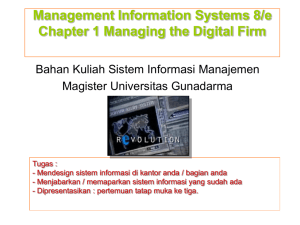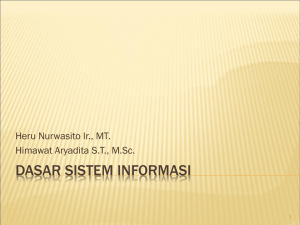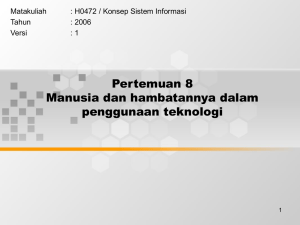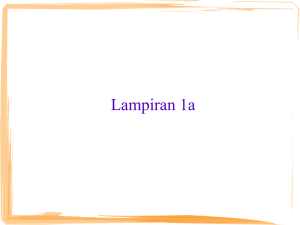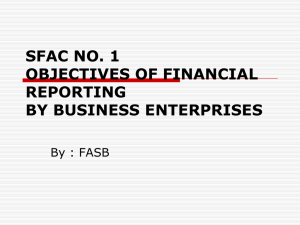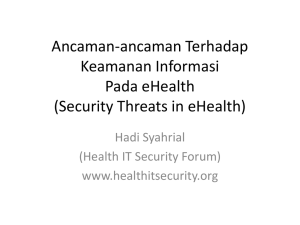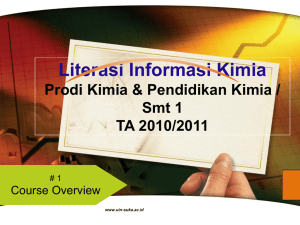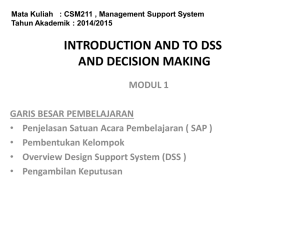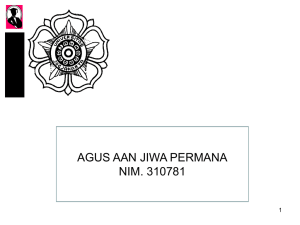information system
advertisement
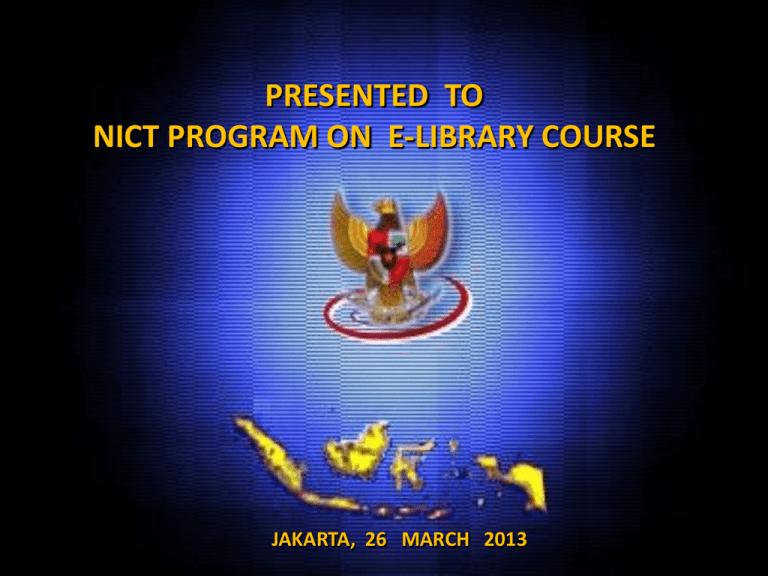
PRESENTED TO NICT PROGRAM ON E-LIBRARY COURSE JAKARTA, 26 MARCH 2013 SUBJECTS TO TALK ABOUT INFORMATION SYSTEM 1. Pendahuluan 2. Information System 3. Main System Components 4. Steps in Data Conversion into Information 5. Characteristics of Information 6. The Nature of Information 7. Types of Information Systems 8. Information System Strategic Planning 9. The Right Fit between IT and IS 10. The Three Domains: IS, IT and IM Empat Gelombang Perkembanagn Teknologi ( Futurolog-Alvin Toflfer ) Manusia Bergantung pada alam Abad 18 Th 1945 Teknologi 1000 X 10 X Waktu Gelombang 0 Teknologi Belum Berkembang Revolusi Pertanian Gel 1 Teknologi Cocok tanam Revolusi Industri Gel 2 Tek Mesin Tenaga Revolusi Informasi Gel 3 Tek Mesin Cerdas (Komputer) Pemanfaatan TIK Dunia Kesehatan Dunia Perbankan Dunia Bisnis Dunia Media Massa dan Informasi Dunia Administrasi Perkantoran Dunia Pendidikan 4 Concrete Usage Scenes of Ubiquitous Technology (Life) Case of independent creator Case of grandfather and grandson What do you want for your birthday? I want to go to the aquarium! While watching a cartoon… Oh! A message from Grandpa! With Withaaubiquitous ubiquitousterminal, terminal, ititisispossible possibleto towatch watch cartoons cartoonsanytime, anytime,anywhere. anywhere. I am going to actually perform the choreography that I have worked out, so take a look. I will send a script I just amended here. Collaboration Collaborationon onaamulti-screen multi-screen In charge of choreography In charge of script Image of costumes for the △△ role are ready so take a look. The main theme song is finally ready. What do you think? In charge of music In charge of clothing When it is ready I will try distributing on the web. If the response is good I will actually perform it later. Send Sendchoreography choreographyas assolid solidimages images OK, I will pay the fee so why don’t you enjoy the virtual aquarium? Anybody Anybodycan cancreate create (musical (musicalcreation creationwith withNet Netfriends) friends) Wow! The shark just got bigger! It is like I am actually in the sea. Screen Screenadapts adaptsto tothe thesounds sounds in inthe thelarge-screen large-screen virtual aquarium. virtual aquarium. Notice Tomorrow is the excursion so we will meet at 8:30. Please make sure to bring a lunch box. In charge ○○ ICT penetrates into every area of life. There is a bicycle 2m ahead. Take care. Encourage Encouragethe thedriver driverto to pay payattention attentionand and contribute to prevention contribute to prevention of ofaccidents accidents The Thesensor sensordetects detects and andnotifies notifies concerning concerningobstacles obstacles Checks Checkson onstate stateof ofher her children. children.Check Checkcontact contact items via e-mail. items via e-mail. They are playing happily. I need to prepare a lunch box tomorrow so I must go shopping on the way home. Supports Supportsideal ideallifestyle lifestyle based basedaround aroundreturn returntime. time. A pedestrian is trying to cross the crossing. Guides Guidesto toregistered registered destination destinationwith withsimple simple operations operations I must slow down and pay attention. Case of the handicapped Cross the pedestrian crossing 5m ahead to the right. A hot bath ready 5 minutes after returning home. Food ready 10 minutes after coming out of the bath. Cleaning complete by return time. Case of working parents 5 Concrete Usage Scenes of Ubiquitous Technology (Industry) Efficiency in production management processes within corporations Realize flexible collaboration between corporations Management Server - distribution history ・流通履歴 - stock information ・在庫情報 Weaving factory Apparel distribution center Theater Travel agency Retailer Restaurant Reference: product code Color Size etc. Reference: product code Color Size etc. Reading via electronic tag reader Electronic tags Reference: product code Color Size Cloth, materials etc. Agent Robot Hotel Airline Reading via electronic tag reader Reading via electronic tag reader Inspections of incoming/outgoing shipments, stocktaking Shipping inspection Electronic tags Inspections of incoming shipments, stocktaking Example of system that links various companies together to meet travelrelated needs and provides a system for processing. Example of supply-chain management for apparel company (management of orders, stock and distribution) Example of system of document management within a company (confirm location of documents, security management) ICT penetrates into all areas of industry Security management セキュリティ管理 Position information 位置情報管理 management Document 書類B B Tag reader タグリーダー Document 書類B B Example of system to support appropriate provision and application of medicine at hospitals etc. Medicine storage room 薬品保管室 Doctor 医師 Direction on taking 薬の処方の指示 medicine Documents 持出し禁止 not to be taken 書類です! out NW Medical DB 医療DB Documents コピー禁止 not to be 書類です copied Detection of NW Check チェック チェック Check 移動検知 relocations チェック Check Management 管理部門 department サーバー Server Tags タグ Car rental NW タグ Tag タグ Tag タグ Tag タグ 媒体情報 Media information DB DB Advanced knowledge management within corporations タグ 患者の取り違えチェック Check it is correct patient Send alarm if incorrect 取り違えている場合アラーム Check amount of 投薬の量チェック medicine given 量が違う場合アラーム Send alarm if amount incorrect Check type of medicine given 投薬の種類チェック 薬が違う場合アラーム Send alarm if incorrect Penetration of ICT use into all areas of industry 6 Radio 2.0 education Information Media Comm. Shopping Search Entertainment Bisnis, Education, Produk, Community, Virtual Network Internet is Platform Information System • A system that creates, processes, stores, and generates information to help individuals make meaningful decisions. 8 Field of Information Systems • The study of information and its effect on the individual, the organization, and society at large. 9 IS and IT • An Information System is a collection of components that work together to provide information to help in the operations and management of an organization. • Information Technology is the integration of computers, communications equipment, and other technology used in information systems. 10 Five Main System Components • Input – Machines, manpower, raw materials, money, time • Process – Policies, procedures, and operations that convert data into information • Output – Information in the right format, conveyed at the right time and place to the right person • Feedback – Data about the performance of the system • Control – Processing the feedback and taking the necessary action, such as modifying the processes, input, or output 11 Gambar Interaksi Komponen Sistem Informasi I N P UT SOFTWARE MODEL HARDWARE BASIS DATA OUTPUT KONTROL HUBUNGAN ELEMEN SISTEM INFORMASI PROSEDUR ORANG ELEMEN SITEM PE INFORMASI PERANGKAT KERAS PERANGKAT P LUNAK BASIS DATA JARKON DAN KOMDAT Seven Steps in Data Conversion into Information • • • • • • • Collection Classification Sorting,adding, merging Summarizing Storing Retrieval Dissemination 14 Characteristics of Information Characteristic Description Subjective value The value of information differs from individual to individual. Relevance Information should be pertinent to the decision maker. Timeliness Decision makers should receive the information at the right time. Information should be free of errors. Accuracy Meaningful format Information should be presented so that it can be readily used in decision making. Completeness The decision maker should have all necessary information to make a good decision. Information should be readily available to those who need it. Accessibility 15 The Nature of Information TOP MANAGER MIDDLE MANAGER LOWER MANAGER External Internal and External Internal Infrequent Frequent Very Frequent Time Scale Long Years Medium, Weeks/Months Short, Days/Hours Time Horizon Future Future and Historical Historical Constrained Highly Constrained Structured Highly Structured Information Sources Frequency of use Scope Unconstrained Nature of Decision Unstructured 16 4 Types of Information Systems • Personal, Work-Group, Enterprise-Wide Systems • Systems Based on Type of Decision • Strategic Information Systems • Function-Oriented Information Systems – Sometimes information systems are grouped into categories based on the number of individuals who use them: personal systems (one user), work-group systems (a group of users), or enterprise-wide systems (the entire organization). – Decisions can be classified as operational, tactical, and strategic. – Information systems that give a company a significant strategic advantage over its market competitors. These can be transaction processing systems, management information systems, decision support systems, or any combination of these systems. – Systems classified according to their business function: marketing information systems, manufacturing information systems, financial information systems, etc. 17 IS Types used for Decision Making • Systems that support operational, tactical, and strategic decision are broadly classified into the following categories: – Transaction processing systems (TPS) – Management information systems (MIS) – Intelligent support systems (ISS), which include decision support systems (DSS), executive information systems (EIS), and expert systems (ES) • Intelligent support systems (ISS) refer to a group of systems that support decisions requiring the use of knowledge, intuition, experience, and expertise – Decision support systems (DSS) – Executive information systems (EIS) – Artificial intelligence (AI) and expert systems (ES) 18 Functional Based Information System • Information systems can also be classified according to function in these four areas: – – – – Marketing Manufacturing and service Accounting and finance Human resources 19 Why Information ? Intelligence INTELLIGENT MANAGER + wisdom Knowledge + experience Information + context Data + procedure Business Facts 20 The CBIS Model Computer-based Information System (CBIS) Accounting Information System Problem Decisions Information Management Information System Decision Support Systems Problem Solution The Virtual Office Knowledge-based Systems 21 Information System Strategic Planning ANALYSIS PROCESS INPUT BLUE PRINT INTERNAL & K R P R O Corporate History Constraints and Opportunities EXTERNAL Industry Trend CULTURE PEOPLE POLICIES S A R H Cost/Benefit Analysis Technical Design Implementation Plan H E List of Scenarios Priorities Level and Schedule VALUE LEGAL ASPECT R STRATEGIC PLANNING Project Management STANDARD S Information Management Strategy Risk Management PROCEDURES Competitor Analysis Best Practice S FINANCIAL RESOURCES VISION MISSION CSFs KPIs STRATEGY BUSINESS PROCESS Information Technology Supply R COMPANY ASSETS COMPANY GEOGRAPHICAL TOPOLOGY Information Technology Development Benchmarking E TECHNOLOGY INFRASTRUCTURE ORGANIZATION STRUCTURE E N Information System Requirements N T Existing Information Technology Strength and Weakness THREE DOMAINS T W Business Plan Approach and Methodology A O L D E Human Resource Skills and Competencies Requirements Change Management Macro Environment Ideology, Political Agenda, Economic Environment, Social and Culture, International Relationship, National Defense, Religion, Behaviors, 22 The Right Fit between IT and IS • IS managers ensure a fit between information systems and technologies through computer architecture – Computer architecture is the major components needed to build a system and an analysis of how the components fit together • Information technologies help build the information infrastructure – The infrastructure are the physical components required to implement the architecture, such as wiring, cables, software, etc. 23 ITs that Build Information System Payroll System Inventory System INFORMATION TECHNOLOGIES •Hardware •Software •Databases •Networks •Other related components INFORMATION SYSTEMS Marketing System Customer Service System 24 Role of Information Technology INTELLIGENT MANAGER + wisdom Knowledge EXECUTIVES + experience Information LINE MANAGER + context Data SUPERVISOR + procedure Business Facts STAFF 2. Help Empowering the People 1. Help Creating the Intelligence Intelligence 25 Internal IT Organization Structure CEO CIO Control and Quality Assurance INFORMATION SYSTEM INFORMATION TECHNOLOGY INFORMATION MANAGEMENT Company Supports Technology Infrastructure Supports and Services Business Intelligence Application Development Outsourcing Organization Analysis Tools and Supports Training and Development Others Others Others INFORMATION TECHNOLOGY COUNCIL 26 Management Information System EXECUTIVE INFORMATION SYSTEM Querying System •Chief Executive Officer •CIO, COO, CFO, CTO •Senior Executives DECISION SUPPORT SYSTEM Reporting System •Line Managers •Junior Managers MANAGEMENT INFORMATION SYSTEM TRANSACTIONAL INFORMATION SYSTEM Consolidation System •Supervisors •Assistants DATAWAREHOUSE DATABASE DATABASE DATABASE DATABASE Transaction System TRANSACTION TRANSACTION TRANSACTION •Users •Customer Services TRANSACTION 27 MIS Applications Portfolio Business Partners Suppliers, Distributors, Resellers Supply Chain Management Enterprise Resource Planning Administrative Control HRMS – ORMS - Purchasing Stakeholders Enterprise Application Integration Management Control Knowledge Tone Applications Finance – Accounting - Auditing Employees Logistics – Production - Distribution Customer Relationship Management Marketing – Sales – Customer Service Selling Chain Management Internet Customers, Resellers 28 Indrajit (2000: 29) mengemukakan bahwa tiga hal pokok yang perlu dipahami secara menyeluruh apa yang harus diperhatikan dan dipertimbangkan untuk menghasilkan sebuah sistem informasi terintegrasi yang baik adalah: 1. Sistem informasi, merupakan definisi secara jelas dan terperinci sehubungan dengan jenis-jenis informasi apa saja yang dibutuhkan oleh perusahaan (dalam hal ini perpustakaan) dan hal-hal yang berkaitan dengan (kecepatan proses pengolahan data menjadi informasi, tingkatan detail informasi, cara penampilan informasi, volume dan transaksi informasi, penanggung jawab informasi, dsb.) 2. Teknologi informasi, meliputi komponen-komponen perangkat keras (komputer, infrastruktur, alat komunikasi, dan lain-lain) dan perangkat lunak (aplikasi, sistem operasi, database, dan lain-lain) yang harus tersedia untuk menghasilkan sistem informasi yang telah didefinisikan. 3. Manajemen informasi, menyangkut perangkat manusia (brainware) yang akan menginplementasikan sistem informasi yang dibangun dan mengembangkan teknologi informasi sejalan dengan perkembangan perusahan di masa mendatang. Berikut ini akan diberikan beberapa contoh nyata pemanfaatan perspektif strategi sistem informasi yang sejalan dengan visi sebuah organisasi. 1. Strategi Sistem Informasi Perguruan Tinggi Sebagai contoh, Dengan adanya paradigma baru, sudah selayaknya bagi universitas menyediakan perpustakaan terintegrasi yang memberikan keleluasaan bagi para mahasiswa untuk menggali potensi dirinya. Salah satu contoh peran perpustakaan terintegrasi dalam pendidikan jarak jauh (distance-learning), karena ia menggantikan peran dan fungsi pendidikan sebagaimana dalam pendidikan tatap muka. Perkembangan mutakhir dalam bidang information communication technology (ICT) memberikan peluang bagi perpustakaan perguruan tinggi untuk memenuhi kebutuhan mahasiswa yang beragam INFORMATION SYSTEM Research and Development Processes People and Culture Electronic Commerce Management Human Resources Products and Services Infrastructure INFORMATION TECHNOLOGY Rules and Policy Organization Standards and Procedures Internet Intranet Digital Nervous System ISDN, VSAT Extranet Cost and Investment COMPUTER Market and Customers Electronic Data Interchange HARDWARE Strategic Business Plan Decision Support System Data Mining Printer Modem Workgroup Computing Outsourcing Operating System PC Desktop Notebook and Palmtop Macro Environment SOFTWARE Multimedia Database Applications Programming Languages Information Management Corporations Business Entities Public Sectors Non Profit Organization Community Institutions INFORMATION SYSTEM - DEMAND SITE - INFORMATION MANAGEMENT INFORMATION TECHNOLOGY - SUPPLY SITE Software Houses Universities Computer Manufacturers Silicon Valley R&D Centers 32 The Three Domains: IS, IT and IM What ? IS Strategy Division/function based Demand oriented Business focused Applications Wherefore ? IM Strategy Organisation based Relationship oriented Management focused How ? Management IT Strategy Activity based Supply oriented Technology focused Delivery 33 Three Parts of MIS Development Stage PART ONE PART TWO PART THREE Information System Requirements Information Technology Specification Information Managemnet Strategy 34 The Main Principles The Demand The Supply The Plan PART ONE PART TWO PART THREE Information System Requirements Information Technology Specification Information Managemnet Strategy What kind of information does the organization need to support its daily activities and what kind of information characteristics/ properties (any related issue w.r.t. the process of information creation and distribution) required by the organization ? What kind of appropriate technology specification required by the organization to answer its information system requirements defined previously by the organization w.r.t. its information characteristics and/or properties ? What kind of management strategy does the organization should adapt in order to guarantee the successful development and deployment of the informationt technology projects within the organization ? 35 The Main Stages and Phases STAGE I STAGE II STAGE III Information System Requirements Information Technology Specification Information Managemnet Strategy PHASE A Organization Strategic Plan Assessment and Analysis PHASE F IT System-Business Process Analysis and Mapping PHASE K Taks Force Appointment and Responsibilities Determination PHASE B Organization Business Process Mapping PHASE G IT Conceptual Architecture Framework Development PHASE L Projects Portfolio Mapping and Schedule Development PHASE C Required Data and Information Characteristics/Properties Mapping PHASE H Application and Database Modules And Standard Specification PHASE M General IT Project Management Development and Deployment PHASE D IT Related Activities Value Proposition and Capability Analysis PHASE I IT Hardware, Network, and Infrastructure Standard Specification PHASE N IT Governance Structure and HR Competencies/Skills Determination PHASE E Strategic Priorities Analysis PHASE J User Management and IT Quality Assurance Determination PHASE O IT Masterplan Revision and Future Development Strategy 36 THANK YOU MAY OUR ALLIANCE WOULD BE VERY FRUITFULL
